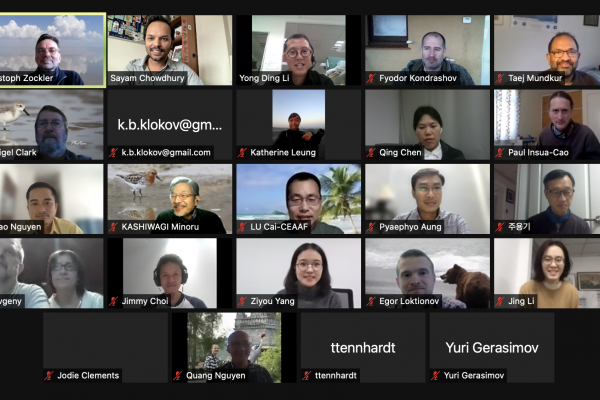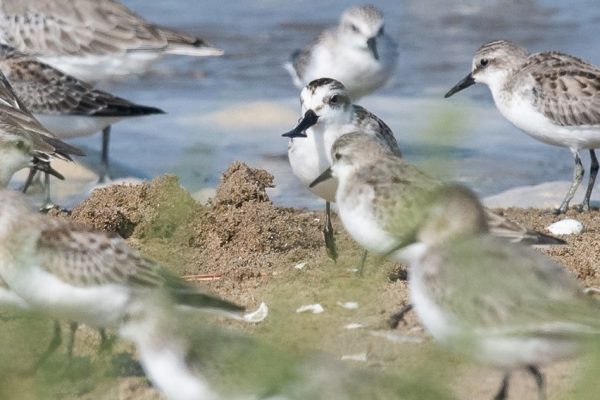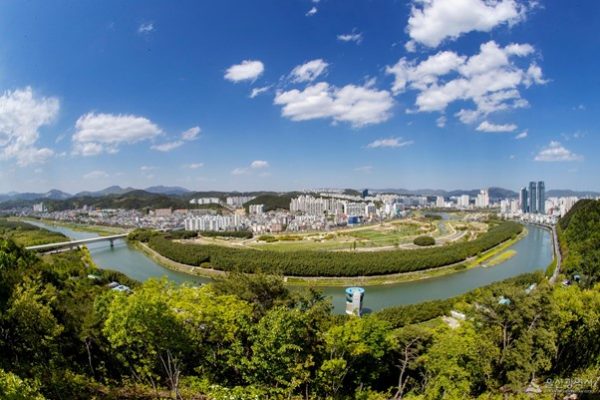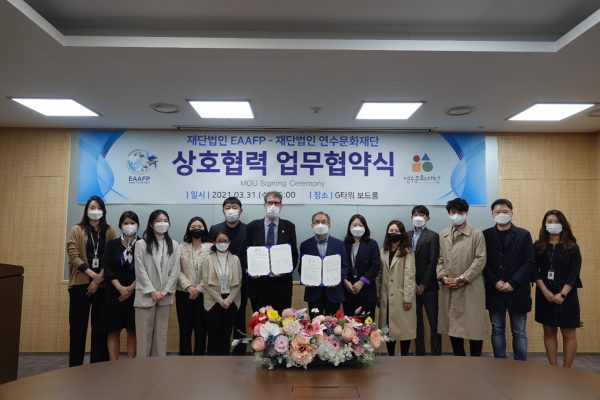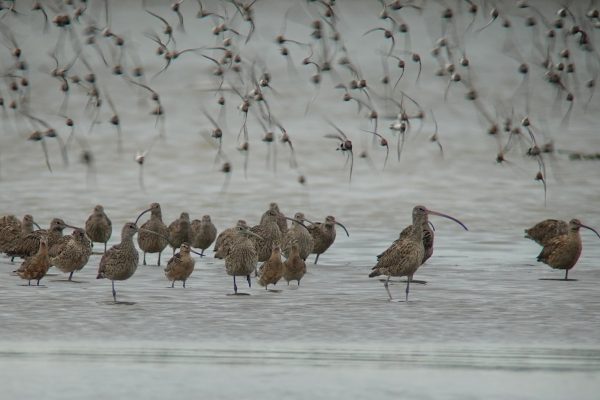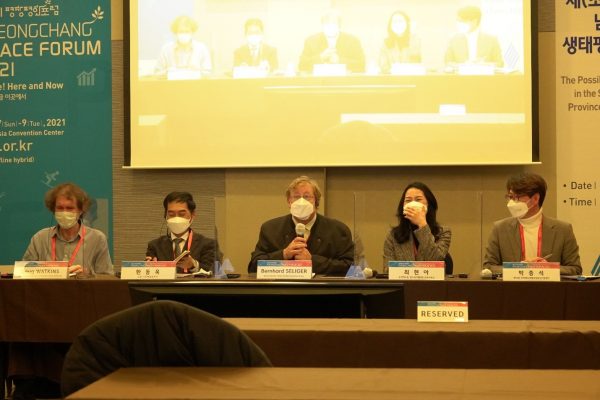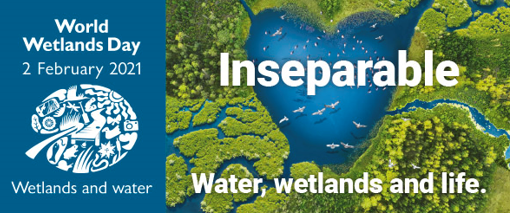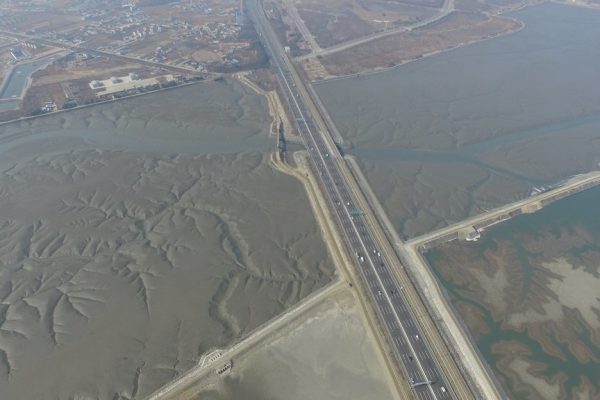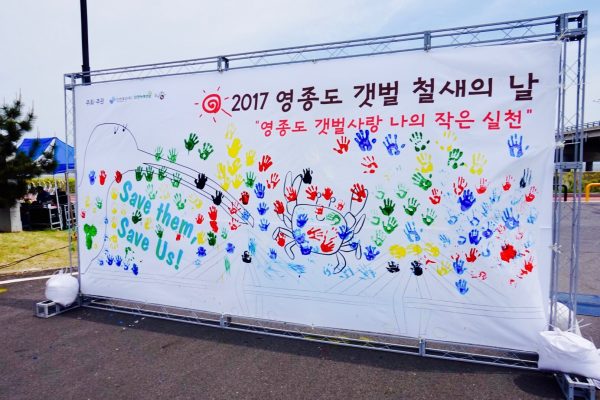-
Spoon-billed Sandpiper Task Force meeting 2021
Drafted by The Spoon-billed Sandpiper Task Force The Spoon-billed Sandpiper Task Force of The East Asian-Australasian Flyway Partnership (EAAFP) completed a two-days online meeting between 24 and 25 November…
Continue reading -
Getting Getbol (intertidal mudflats) of the Republic of Korea into World Natural Heritage Site inscription
Spoon-billed Sandpiper in Yubudo © Henrik Thorlund The West/Yellow Sea, lies at the heart of the East Asian-Australasian Flyway, a migratory route for 50 million migratory waterbirds traverse on an annual basis which stretches from Russia Far East and Alaska, U.S.A. south to Australia and New Zealand covering 22 countries. This region is surrounded by three countries: The People’s Republic of China, the Democratic People’s Republic of Korea (DPR Korea) and the Republic of Korea (RO Korea). The wetland habitats in this region, especially the intertidal mudflat in this area serve as fuelling, staging stations for two million shorebirds, or 40% of total birds in the Flyway, annually. However, the intertidal mudflat in this region has shrunk by over 65% in past decades, but recent studies in countries outside the Yellow Sea region showing rapid declines of migratory shorebirds strongly related to the loss of the birds’ habitats in the West/Yellow Sea. This illustrates the sites in different countries along the Flyway are highly interconnected due to the migratory waterbirds, and it is crucial to protect, as it is one of the world’s most important migratory bottlenecks for watebirds. The Government of the Republic of Korea has nominated 4 sites of intertidal mudflats, or “Getbol” in Korean, on the country’s southwestern coast of the Yellow/West Sea as the candidate of UNESCO’s World Heritage listing. This group of four sites included in the Phase I nomination are Seocheon Getbol (EAAF101), Gochang Getbol, Shinan Getbol (EAAF146) and Boseong-Suncheon Getbol (EAAF079), covering over 128,000 ha (or 1280 km2) of wetlands. Apart from its spectacular geological processes, these areas are rich in biodiversity, with 2,169 invertebrate species, 857 macrobenthos, 152 marine macroalgae, 47 endemic and 5 endangered marine invertebrate species recorded. The richly diverse benthic community supports a huge number of migratory waterbirds. In addition, the endangered Narrow-ridged Finless Porpoise is often found in the waters within the nominated sites. Hooded Crane in Suncehon Bay © Suncheon City Office Bird surveys have revealed that these sites supported 102 waterbird species and some 34 species with internationally important numbers. The sites were crucial for 15 globally threatened waterbird species including Spoon-billed Sandpiper (CR), Far Eastern Curlew (EN), Nordmann’s Greenshank (EN), Great Knot (EN), Black-faced Spoonbill (EN), Hooded Crane (VU), Saunders’s Gull (VU), Chinese Egret (VU) Swan Goose (VU), Relict Gull (VU), Horned Grebe (VU), White-naped Crane (VU) and Common Pochard (VU). The nomination would also secure the reintroduced population of Oriental Stork (EN). Legflag observations and satellite tracking data furthered confirmed the nominated sites interlinked with other countries in the Flyway. Because of such ecological connectivity of the migratory waterbirds along the Flyway, the World Heritage inscription is not just a matter to the Republic of Korea, as it contributes to assuring that the critical staging area for migratory waterbirds in the Flyway is secured. It is essential to safeguard the integrity of Yellow/West Sea intertidal flat, together with the on-going designation of World Heritage Sites along China coast of the Yellow Sea and potentially with the habitats along DPR Korea at a future date. The future of millions of migratory waterbirds now lay on the hands of the World Heritage Committee to agree on the “Outstanding Universal Value” of this Getbol nomination. The result announcement for this nomination will be made at the upcoming annual meeting of the World Heritage Committee in China in July 2021. Watch the video about the Getbol: Click [here] or the image to enjoy the photo book: Suncheon Bay © Suncheon City Government
Continue reading -
Welcome Ulsan Taehwa River in the Republic of Korea as the new EAAFP Flyway Network Site
On 13th May, 2021, the EAAFP welcomed the Taehwa River in Ulsan Metropolitan City of Republic of Korea as EAAFP 150th Flyway Network Site (FNS) and as 17th FNS…
Continue reading -
MOU Signing Ceremony between EAAFP Foundation and Yeonsu Foundation for Arts and Culture
EAAFP Foundation and Yeonsu Foundation for Arts and Culture staffs are taking a picture after the MOU signing ceremony…
Continue reading -
The Hwaseong Wetlands Project
Written by Dr. Nial Moores, Birds Korea The Hwaseong Wetlands, centred at approximately 37.115046° 126.731785°, are located in Gyeonggi Bay in the northwest of the Republic of Korea (ROK). Situated on the eastern shore of the Yellow Sea only an hour’s drive south from Seoul and Incheon, the wetlands sit at the heart of the East Asian-Australasian Flyway (EAAF), in a region where temperatures can exceed 35C in July and August, but fall well below zero for much of January. As a result, almost all waterbirds found in the Hwaseong Wetlands are long-range migrants, with some species flying the length of the Flyway every year. Formerly known as Namyang Bay, the Hwaseong Wetlands were created in their present form by the completion of a 9.81km long outer sea-dyke in 2002 which destroyed thousands of hectares of tidal flat and shallow marine waters, and caused huge damage to the livelihoods of many local fishers and to shorebird populations. The same reclamation process, however, left 1,000ha of outer tidal flat and also inadvertently created a large brackish reclamation lake, now used by flocks of Black-faced Spoonbills and rafts of diving duck; freshwater ponds and reedbeds; and rice-fields which support thousands of foraging geese in October and November The Hwaseong Wetlands © Jung Hanchul, Gyeonggi KFEM The area was first recognized as internationally important for waterbirds back in 1988. Subsequent government research effort there between 1997 and 2003 found an estimated 70,000 shorebirds annually during northward migration, identifying Namyang Bay as the second most important site for shorebirds in the ROK after the now-reclaimed Saemangeum. Post-reclamation, because of massive habitat change many species of shorebird declined, but geese and duck increased. Fortunately, research between 2015 and 2018 by the local NGO - Hwaseong KFEM confirmed the continuing international importance of the area for waterbirds, and the Hwaseong Wetlands were finally designated as EAAFP Flyway Network Site (FNS) 142 at the Tenth Meeting of the Partners of the East Asian-Australasian Flyway Partnership (EAAFP) in late 2018. As discussion between Hwaseong City and the EAAFP Secretariat progressed toward designation of part or all of the Hwaseong Wetlands FNS as a Ramsar site, multiple questions arose. These included which Ramsar criteria the wetlands still met; what the best site boundaries should be; and what kind of management approaches might be needed. An MOU was signed early in 2020, and soon after the Hwaseong Wetlands Project was launched. A collaboration between Hwaseong City, the sponsor of the project, the EAAFP Secretariat, Hwaseong KFEM, National KFEM and Birds Korea, the Wetlands Project, under the sub-project “National Cooperation for Hwaseong Wetlands and Establishment of a Korean Far Eastern Curlew Network”, was conducted between June 2020 and mid-March 2021 and aimed to answer these questions while continuing the all-important process of building support for conservation among local people. During 49 days of fieldwork led by Birds Korea, more than 131,000 individual waterbirds of 110 species were counted within the FNS. Furthermore, the peak count among surveys indicated 83,232 individuals of 57 species between 17th and 18th November in 2020. This total included internationally important concentrations of 19 waterbird species, seven of which are globally threatened. In all, 91,000 geese and duck were recorded, and more than 28,000 shorebirds were counted during southward migration alone, including a conservative count of 2,275 Far Eastern Curlew. The Project Surveys therefore helped confirm that the Hwaseong Wetlands FNS meet multiple Ramsar criteria for the identification of internationally important wetlands. Far Eastern Curlew and other shorebirds in Hwaseong Wetlands © Nial Moores, Birds Korea In addition, repeat counts within the Hwaseong Wetlands FNS and at adjacent wetlands helped us to confirm the ecological interconnectivity of the different habitat components and to identify movements of waterbirds between wetlands. The Project surveys therefore helped in the refinement of wetland boundaries and also confirmed the international importance of adjacent wetlands, from Asan Bay in the south, to the Maehwari tidal flats to the north. During the same period, Hwaseong KFEM led the Project’s CEPA work, holding multiple meetings with local stakeholders and educator groups, gathering opinions of local fisherfolk, and supporting the development of a photo exhibition and no less than three documentaries for broadcast on local and national TV! The data from the surveys contributed to the establishment of the Far Eastern Curlew Network of the Korean Peninsula. Hwaseong City led the establishment of the Network with other local governments where Far Eastern Curlews’ habitats are, Seocheon County of Chungcheongnam-do and Yeonsu district of Incehon. Together with the EAAFP Secretariat, all project partners also helped to organize the third international Wetlands Symposium in three years, held in Hwaseong City on December 1st 2020. Finally, to organize information gathered during the project and to support management decisions in the future, Birds Korea, the EAAFP Secretariat and Hwaseong KFEM coauthored a project report, which after professional layout was published in Korean in March 2021. Download via: https://www.eaaflyway.net/wp-content/uploads/2021/03/Wise-Use-of-the-Hwaseong-Wetlands_Kor_online-compressed.zip The English-language version, while not formally published, is now available for download from the EAAFP website [here]. Follow the updates and see the birds in Hwaseong Wetlands: https://www.facebook.com/EAAF142 Oriental Stork, Hwaseong Wetlands © Jung Hanchul, Gyeonggi KFEM 화성습지 프로젝트 새와 생명의 터 나일 무어스 박사 작성 화성 습지는 약 37.115046° 126.731785°, 대한민국 북서부 경기만에 위치하고 있다. 서울과 인천에서 남쪽으로 차로 한 시간밖에 떨어지지 않은 황해 동쪽 해안에 위치한 습지는 동아시아-대양주 철새이동경로(EAAF)의 중심부에 위치해 있으며, 7, 8월에는 기온이 35°C를 웃돌지만 1월은 상당 기간 영하로 떨어진다. 그 결과 화성습지에서 발견되는 물새는 거의 대부분 장거리 이주새로, 일부 종은 매년 동아시아-대양주 철새이동경로만큼의 거리를 난다. 남양만이라 불리던 화성습지는 2002년, 수천 ha의 갯벌과 얕은 해양수역을 파괴하고 많은 지역 어민들의 생계와 도요물떼새류 개체군에 막대한 피해를 입혔던 길이 9.81㎞의 바다 제방 완공 이후 현재 모습으로 조성되었다. 그 개간 과정으로 인해 저어새와 잠수 오리류 무리가 사용하는1000ha의 갯벌과 큰 간척호, 민물 연못과 갈대밭, 그리고 10월과 11월에 먹이를 찾는 수천 마리의 기러리류를 지원하는 논밭이 우연히 생겼다. 화성습지 © 정한철, 경기환경운동연합 1988년 처음 이 지역이 물새들에게 국제적으로 중요한 지역이라는 것이 인식되었다. 1997년에서 2003년 사이 정부 조사 결과 매년 약 7만 마리의 도요물떼새류가 북쪽으로 이동하는 것이 발견되면서, 남양만은 현재 복원된 새만금 다음으로 한국에서 두 번째로 도요물떼새류에게 중요한 곳으로 밝혀졌다. 개간 후, 대규모 서식지 변화 때문에 많은 종의 도요물떼새류가 감소했지만, 기러기류와 오리류는 증가했다. 다행히 2015~2018년 지역 NGO인 화성환경운동연합의 조사로 인해 물새들을 위한 지역의 연속적인 국제적 중요성이 확인되었으며, 화성 습지는2018년 말 동아시아-대양주 철새이동경로 파트너십 (EAAFP) 제10회 총회에서 마침내 EAFFP 철새이동경로 네트워크 사이트 (FNS) EAAF142로 지정되었다. 2020년 초에는 MOU가 체결됐고, 곧이어 화성습지 사업도 출범했다. 이번 사업의 후원사인 화성시와 화성환경운동연합, 환경운동연합, 새와 생명의 터, 습지 프로젝트(사업명 : 화성습지 국제심포지엄 및 국제협력사업)는2020년 5월부터 2021년 3월 중순까지 추진되었고 지역 주민들 사이에 보전을 위한 지원을 구축하는 모든 중요한 과정을 계속하며 질문에 답하는 것을 목표로 했다. 이의 하위사업인 “알락꼬리마도요 보전을 위한 국제협력사업”의 일환으로, 새와 생명의 터가 주도한 49일간의 현장조사 기간 동안 110종 131,000마리 이상의 물새가 FNS 내에서 집계되었다. 게다가, 조사의 최고 수치는 2020년 11월 17일부터 11월 18일까지 57종 83,232마리었다. 이 수치는 국제적으로 중요한 19종을 포함하고 있고, 그 중 7종은 세계적으로 멸종위기에 처해 있다. 모두 91,000마리의 기러기류와 오리류가 기록되었으며, 남하하는 동안에만 28,000마리 이상의 도요물떼새류가 집계되었으며, 여기에는 적어도 2,275마리의 알락꼬리마도요가 포함되었다. 따라서 프로젝트 조사는 화성 습지 FNS가 국제적으로 중요한 습지 식별을 위한 여러 람사르 기준을 충족하는지 확인하는 데 도움이 되었다. 화성습지에 있는 알락꼬리마도요와 다른 도요물떼새류 © 나일 무어스, 새와 생명의 터 또한 화성습지FNS내와 인접 습지 내에서의 반복적인 조사를 통하여, 다양한 서식지 간 생태적 상호연속성을 확인하고 습지간 물새의 이동을 확인할 수 있었다. 따라서 이번 프로젝트 조사는 습지 경계의 개선에 도움을 주었으며, 또한 남쪽의 아산만에서 북쪽의 매화리 갯벌에 이르기까지 인접 습지의 국제적 중요성을 확인시켜 주었다. 같은 기간 화성환경운동연합은 지역 이해관계자 및 교육단체와 여러 간담회를 열고 지역 어민들의 의견을 수렴하고, 사진전을 구축하고 지역 및 전국 TV에서 방송할 수 있는 다큐멘터리 개발을 3편 이상 지원하는 등 프로젝트 CEPA 작업을 주도했다. 이번 조사에서 나온 자료는 한반도 알락꼬리마도요 네트워크 구축에 기여했다. 화성시는 알락꼬리마도요 서식지가 있는 다른 지방자치단체와 충남 서천군, 인천 연수구 등과 네트워크 구축을 주도했다. 모든 프로젝트 파트너들은 EAAFP 사무국과 함께 2020년 12월 1일 화성시에서 3년 만에 열린 제3회 화성습지 국제심포지엄 개최를 도왔다. 끝으로 사업 과정에서 수집된 정보를 정리하고 향후 경영결정을 지원하기 위해 새와 생명의 터, EAAFP 사무국, 화성환경운동연합 등이 공동으로 사업보고서를 작성하였고 이후 2021년 3월 한글로 발간되었다. 다운로드: https://www.eaaflyway.net/wp-content/uploads/2021/03/Wise-Use-of-the-Hwaseong-Wetlands_Kor_online-compressed.zip 공식적으로 출판되지는 않았으나 영어 버전은 현재 EAAFP 웹사이트[here]에서 다운로드할 수 있다. 더 많은 화성습지의 새들을 보고싶다면: https://www.facebook.com/EAAF142 황새, 화성 습지 © 정한철, 경기환경운동연합
Continue reading -
Pyeongchang Peace Forum 2021- discuss on eco-peace tourism through bird watching, Republic of Korea
Gangwon Province, Pyeong Chang County, Korea International Cooperation Agency (KOICA), and Pyeong Chang 2018 Legacy Foundation organized the 2021 Pyeongchang Peace Forum (PPF, https://online.ppf.or.kr/home/eng/ppf/main/main.do), which was held in…
Continue reading -
2021 World Wetlands Day: Restore our wetlands in the East Asian-Australasian Flyway
World Wetlands Day, celebrated every year on 2 February, to raise global awareness of the importance of…
Continue reading -
The Launch of Far Eastern Curlew Network of the Korean Peninsula
Hwaseong City in Ro Korea, where the Flyway Network Site Hwaseong Wetlands (EAAF 142) is located, the main habitat of Far Eastern Curlews, carried out the Hwaseong Wetland Project…
Continue reading -
Yeongjong-do Mudflat Migratory Bird Day (2017 영종도 갯벌 철새의 날)
Event title: Yeongjong-do Mudflat Migratory Bird Day (2017 영종도 갯벌 철새의 날) Organizer: The…
Continue reading

